Perched upon the River Tummel is Pitlochry Dam, part of the Tummel Valley’s hydro scheme which is made up of 9 power stations and 4 major dams.
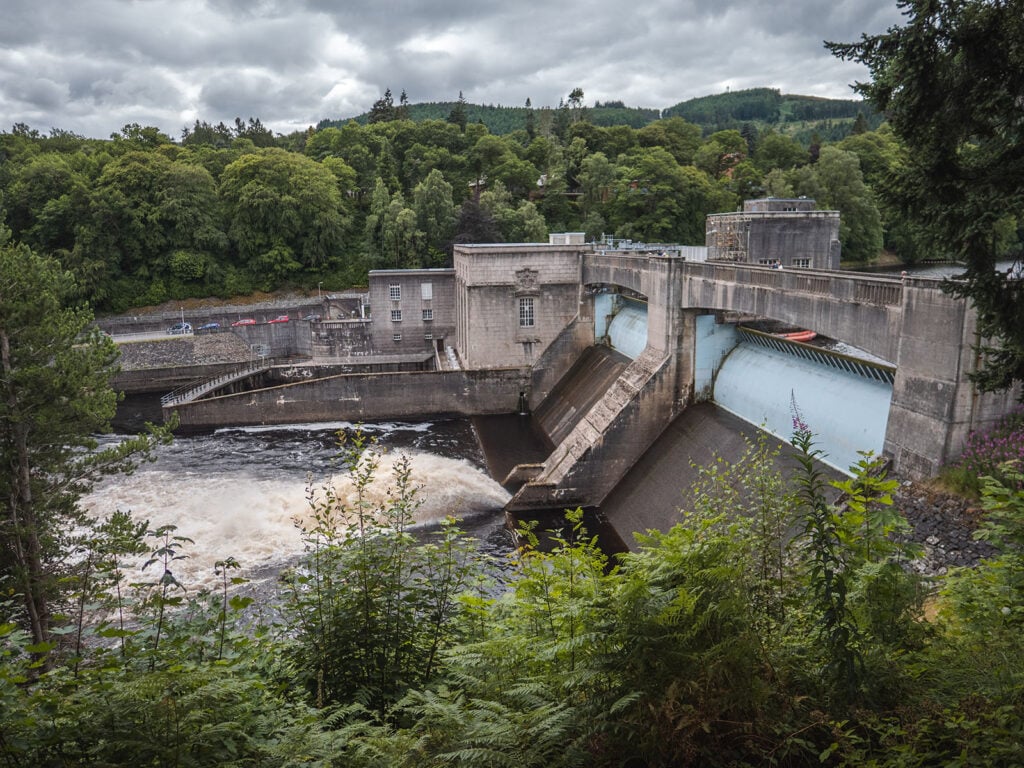
The Tummel Valley was one of the first regions in Scotland to be developed for hydroelectric power in the 1930s and today produces renewable energy for the area.
As well as providing clean energy for this part of Scotland, Pitlochry Dam and its adjacent Visitor Centre are a popular tourist attraction in Perthshire.
In this article I aim to tell you everything you need to know about visiting Pitlochry Dam.
Pitlochry Dam Map
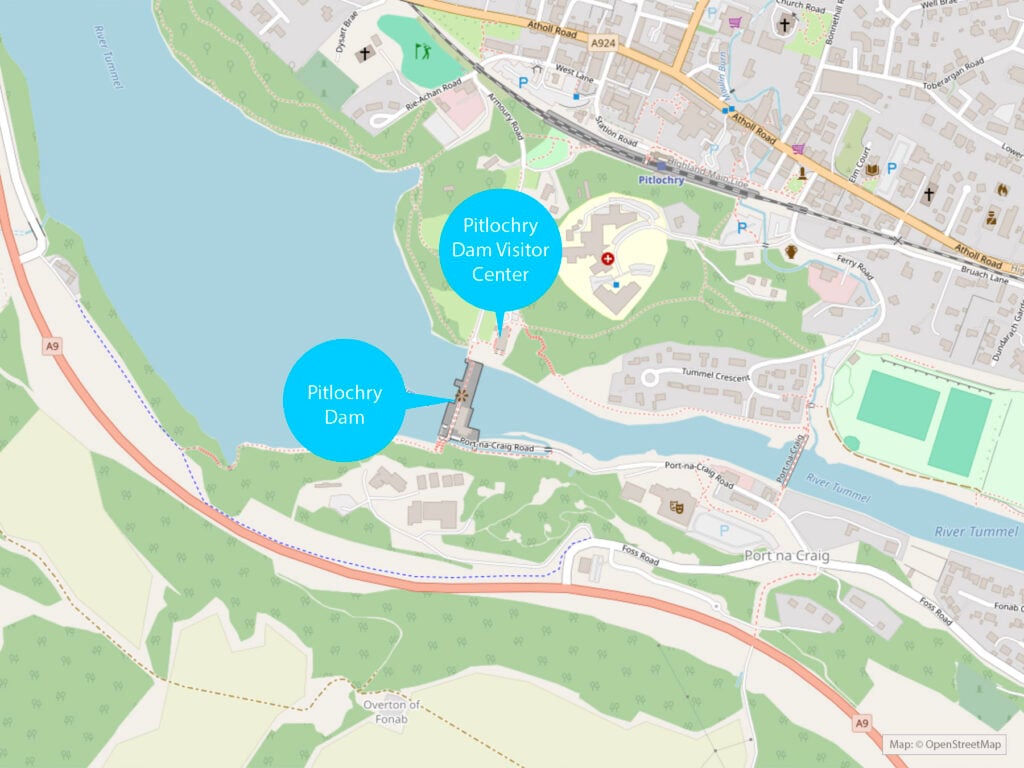
Just here for the walks? Jump to the walks section to see detailed guides on my favourite Pitlochry Dam & Fish Ladder walks including maps, photos, step-by-step directions and GPS files.
Pitlochry Dam Quick Facts
Coordinates: 56°41’58.4″N 3°44’24.0″W
Walk difficulty: Easy
Shortest walk length (return): 20 minutes
Operated by: SSE
Dog-friendly: Yes (including in the Visitor Centre)
Child-friendly: Yes
Best time of year to visit: Spring or summer provide the best opportunities to see fish in the fish ladder.
Best time of day to visit: Any time of day
Entry costs: Free
Car park costs: Free
Opening times: Between 10am and 4:30pm on all days excluding Mondays. Closed on Tuesdays during the winter months.
Food: Visitor Centre has a café
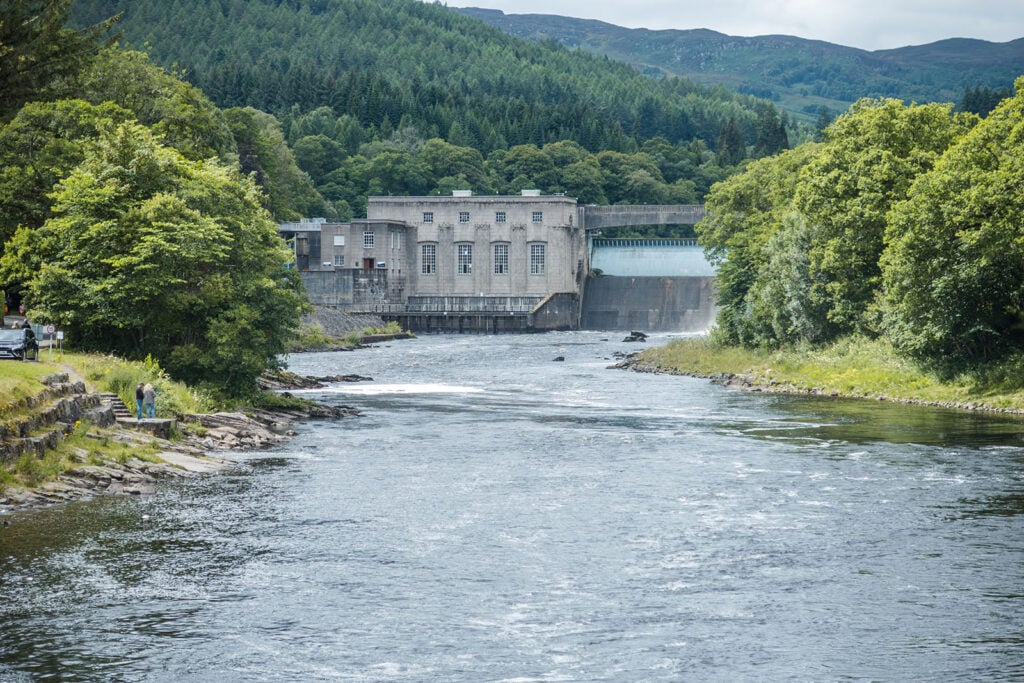
Table of Contents
- What is Pitlochry Dam?
- How does Pitlochry Dam work?
- Pitlochry Dam History
- Who Built Pitlochry Dam?
- The Pitlochry Dam Fish Ladder
- Pitlochry Dam Visitor Centre
- Planning Your Visit to Pitlochry Dam
- Pitlochry Dam Circular Walk
- Other Things to Do in Pitlochry
- Where to Stay in Pitlochry
- Final Thoughts: Is Pitlochry Dam Worth Visiting?
You may also be interested in my other Perthshire guides on the stunning Tay Forest Park – of which Pitlochry is a part of – and the picturesque Falls of Bruar which are just a short drive from Pitlochry Dam.
What is Pitlochry Dam?
Pitlochry Dam is part of Scotland’s pioneer hydroelectric schemes and a fantastic example of the fusion between nature and energy creation. The grand structure is both a power station and a dam.
Construction of the dam started in 1949, part of an ambitious scheme to create 78 dams and 54 power stations across the Scottish Highlands.
Pitlochry Dam is one of nine power stations that were constructed in the Tummel Valley hydroelectric scheme. It has two turbines which supply electricity for 15,000 homes.
As well as being a working power station, Pitlochry Dam is a popular destination for visitors in the Perthshire area. Not only is it awe-inspiring to stand atop the dam and witness thousands of gallons of water gushing out of the dam, but this activity is completely free of charge, providing an ideal day trip for travellers sticking to a budget. You can see more budget travel destinations on Lottoland.
The energy complex has a complimentary visitor centre which overlooks the dam. Here you can learn more about the power station and its fish ladder as well as grab a bite to eat at the café.
Good to Know! The same water can pass through electricity-generating turbines up to five times.

How does Pitlochry Dam work?
Hydroelectric dams such as Pitlochry Dam are designed to encapsulate the power from moving water in order to generate electricity.
Typically a hydroelectric power station will have a large body of water such as a reservoir at the top. In the case of Pitlochry Dam we have Loch Faskally just above it, a loch which was formed as a result of the dam’s creation.
There is a gate within the dam to control just how much water flows down into the river below.
Just as the water starts to tumble down the dam, it creates kinetic energy. On its way down it passes through a turbine which will spin due to the force of the water. This creates electricity.
To operate effectively, dams require large amounts of water with a big drop in elevation to maximise the water flow.
Think of it in the same way that wind moves the propellers on a windmill, with the turbine capturing the energy that is created.

Pitlochry Dam History
Back in the 1940s only one in six farms and one in 200 crofts in the highlands had electricity.
Politician Tom Johnston set-out a vision for creating a hydroelectric scheme in the Scottish Highlands. Not all residents however approved of the plan, many concerned that it would decimate the Scottish landscape.
In fact a project encouraged residents to protest and write to their MPs in order to stop the construction of the hydroelectric plants and dams.
“No-one acquainted with the scenic beauty of the Pitlochry district can fail to feel dismay at the prospect of that beautiful and historic piece of country being desecrated by the proposed scheme.
“River beds will be dried up; the Falls of Bruar will become a mere trickle; Clunie Bridge, the recreation park and many homes and farms will be submerged; and the Queen’s View and many other delightful scenes will be altered out of all recognition.
“There will, too, be great monetary loss to the township of Pitlochry, where many a weary city dweller has spent a pleasant and restful holiday.”
– Petition against Pitlochry Dam
Following the uproar the plans were debated in parliament. Despite debates, construction went ahead anyway in 1947 and the first concrete block was laid by the Countess of Airlie.
Care was taken in the dam’s design, ensuring it blended into the landscape as much as possible. More importantly, however, was the incorporation of a fish ladder, enabling migrating fish such as salmon to still be able to travel up and downstream without being hindered by the dam.
The dam took four years to build, annual flooding at the site leading to delays.
As the dam was being built in an existing river it required a system of coffer dams in order to control the spread and flow of water through the site which caused further complications.
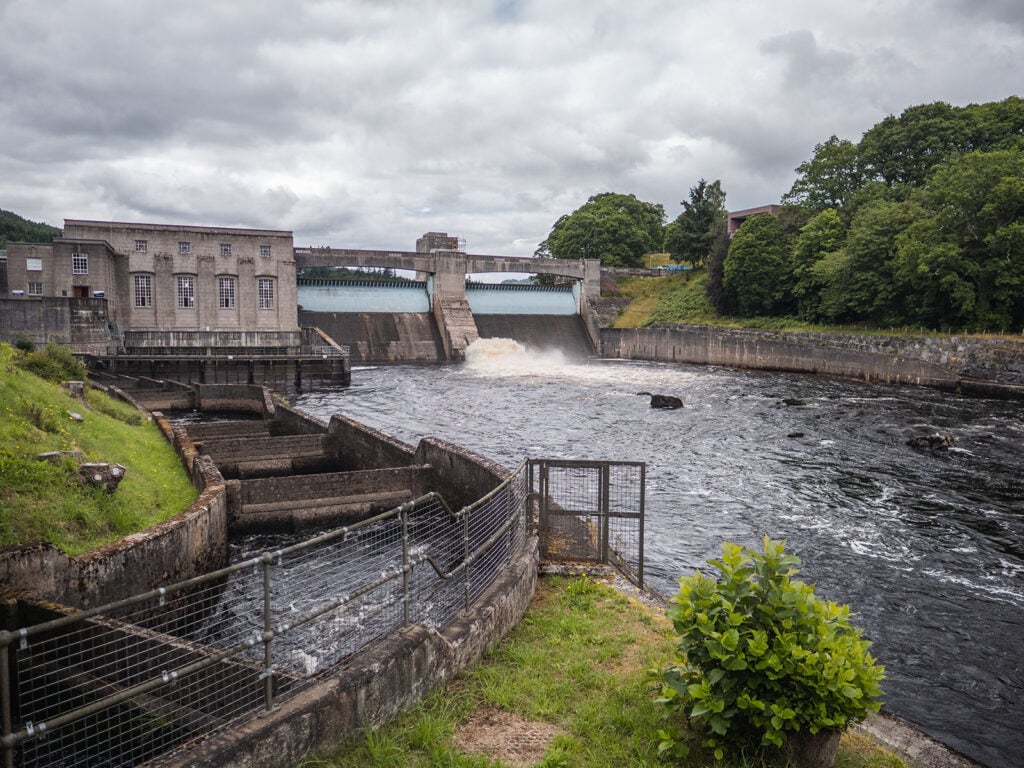
Adding additional delays to the project was the strike of the workers over poor quality of food.
At last construction finished in January 1951 with an opening ceremony planned for June, later that year.
Sadly Sir Edward MacColl, head engineer of the Hydro Board died suddenly just before the opening ceremony. As a result a more sombre ceremony was hosted in 1952 and a plaque in his honour was unveiled at Pitlochry Dam.
The dam was then up and running. This was the first time a water storage element had been incorporated into hydropower in Scotland, as opposed to simply relying on the natural flow of rivers to generate power.
Thankfully residents’ initial concerns of a decimated landscape didn’t materialise. In fact, the creation of Loch Faskally atop the dam just added to the area’s beauty and increased tourism. The loch became a popular spot for anglers, kayakers, canoeists, paddleboarders and walkers. The forests surrounding the loch are often used to host the award-winning Enchanted Forest spectacle.
The dam’s award-winning visitor centre was opened in 2017, stationed with a glorious panoramic view of the dam.
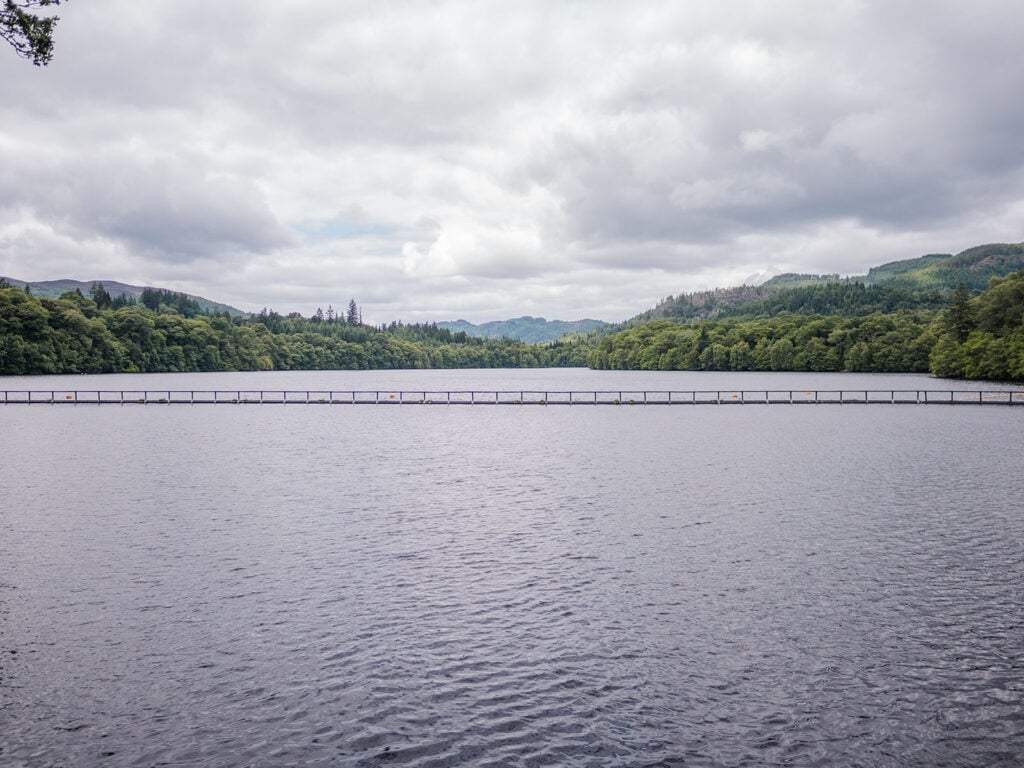
Who Built Pitlochry Dam?
The original project was designed by Balfour Beatty and built by Wimpey Construction to a plan approved by the North of Scotland Hydro-Electric Board.
Men from across Europe were employed to build the dam and, at its peak, there were around 12,000 men working on the several hydroelectric schemes in the highlands, including prisoners of war.
Constructing the dam was no easy feat. One of the dam’s tunnelers, Donegal Tunnel Tigers John ‘Gonna’ O’Donnel recalls:
“Closing my eyes I can still feel the tumbling rocks coming down on my bare knuckles and how the constant drilling affected my hearing so that my ears rang constantly for that first fortnight in Perthshire.”
“If I sniff the air I swear I can still conjure up the smell of the thick, black, choking, dust and smoke which followed each enormous blast.”
Donegal Tunnel Tigers John ‘Gonna’ O’Donnel
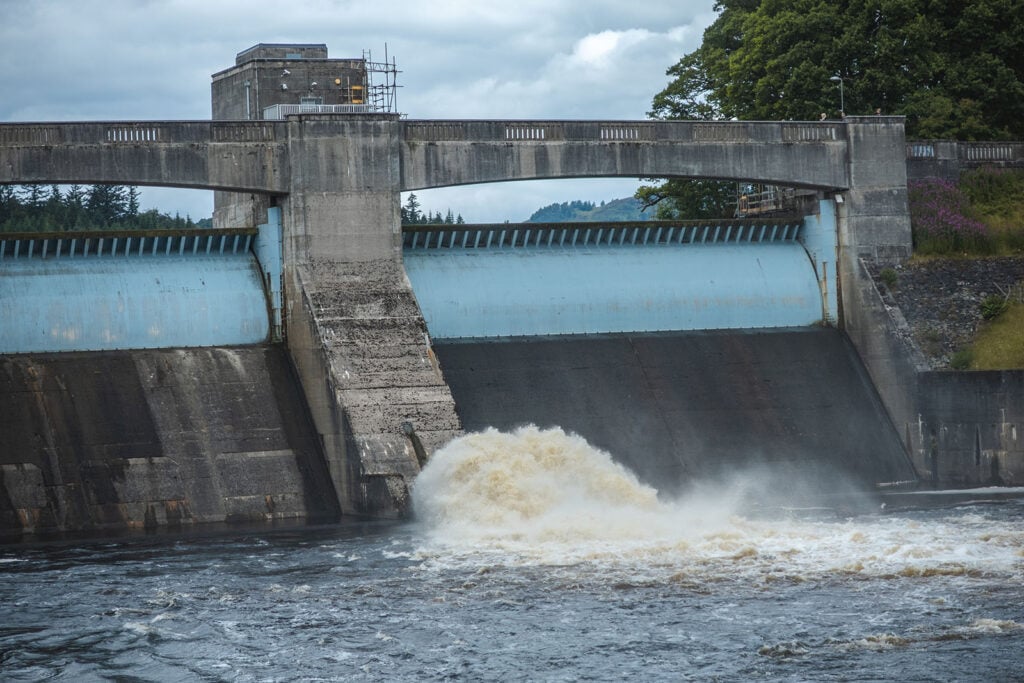
The Pitlochry Dam Fish Ladder
An integral and tourist-friendly part of the Dam is the innovative Fish Ladder. Because thousands of Atlantic salmon and other fish return to the place where they were spawned in order to lay fresh eggs, a way had to be developed to allow them to bypass the dam and follow the river Tummel upstream to spawn.
The innovative solution built into the design of the dam is a 310 metre long Fish Ladder, which allows the fish to pass through the dam en route to their spawning area.
There is a visitor path which climbs alongside the ladder, allowing you the opportunity to search the pools for an elusive salmon.
There is a celebration each January to announce the start of the salmon season. Many salmon start swimming through the ladder in spring with the peak being between April and the end of August. The late salmon run starts in September and ends in October.
Good to Know! For the best chances of viewing salmon in the fish ladder visit between April and the end of August.
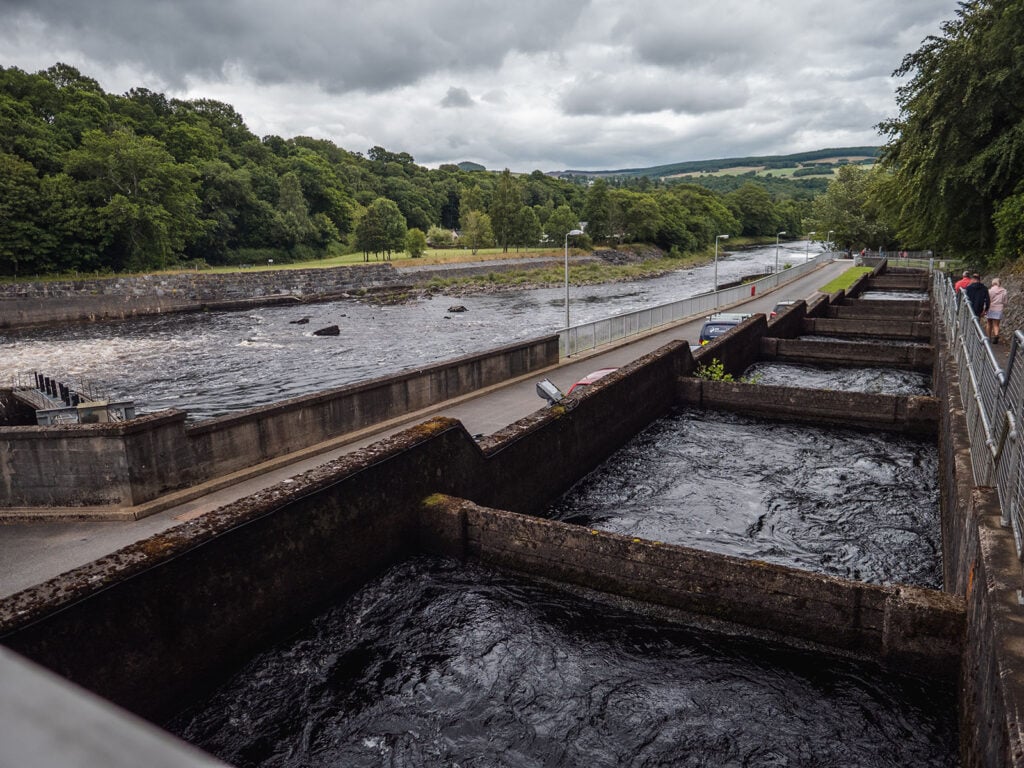
How does the Fish Ladder work?
The Fish Ladder has 34 chambers (including 3 resting chambers to give the fish time to rest during their ascent) which are essentially small, artificial pools, each one with a water level slightly higher than the one below which, in turn, creates a series of steps for the fish to tackle, slowly taking the fish up to Loch Faskally.
The fish swim from one chamber to the next via small circular entrances beneath each wooden entrance to the chambers. These entrances restrict the amount of water flowing from one chamber to the next and a continuous flow of water via these entrances maintains the water level in the pools.

Pitlochry Dam Visitor Centre
The story of the way in which Pitlochry dam harnesses natural energy is told at an impressive Visitor Centre overlooking the Dam, which has been designed to share more about this iconic project.
Opened in 2017, SSE’s new Visitor Centre at the water’s edge is a beautifully designed £4 million building which blends into the surrounding countryside.
It tells the story not just of the Pitlochry Dam but of hydropower in Scotland and has accessible educational materials for children too.
The Visitor Centre is very definitely a tourist attraction in its own right and has been recognised for its value to green tourism both in Scotland and more broadly via awards and acclaim.
Visitor numbers usually exceed half a million people per year.
The Visitor Centre also houses a café and a gift shop.
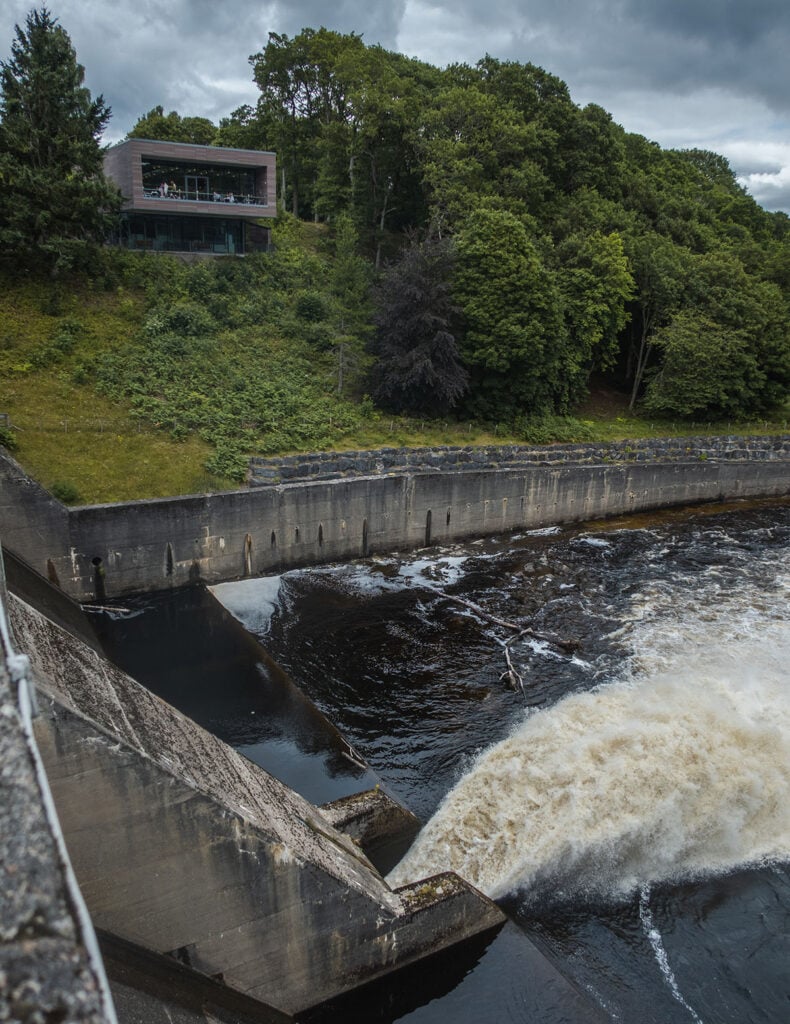
Pitlochry Dam Café
Located at a prime spot in the Visitor Centre, the café doesn’t just provide catering, it offers a stunning view of the rushing waters below as the flow cascades through the Dam and turbines.
There is both outdoor and indoor seating.
The café is of modern design, with the emphasis on the view, and sells drinks, cakes and deli snacks. There is also a gift shop specialising in local crafts.
Pitlochry Dam Webcam
A permanent webcam shoots the waters of the river Tummel at Pitlochry Dam, allowing people to access this impressive site of energy generation combined with natural beauty from anywhere in the world.

Planning Your Visit to Pitlochry Dam
Pitlochry Dam is an accessible and welcoming visitor attraction which is only a short distance from the bustling town of Pitlochry, which is the heart of the local rural economy.
A visit can take maybe three to four hours including a walk from Pitlochry to the Dam, a full sight-seeing experience, and then a return to the town.
Where is Pitlochry Dam located?
Pitlochry Dam and its Visitor Centre can be found around ten minutes by foot from Pitlochry town centre. The road between them is safe and scenic.
There is a free car park conveniently located at the Visitor Centre. It does however get quite busy. There are plenty of car parks and on-street parking options in Pitlochry itself.
The address for Pitlochry Dam is: Armoury Road, Pitlochry, PH16 5AP.
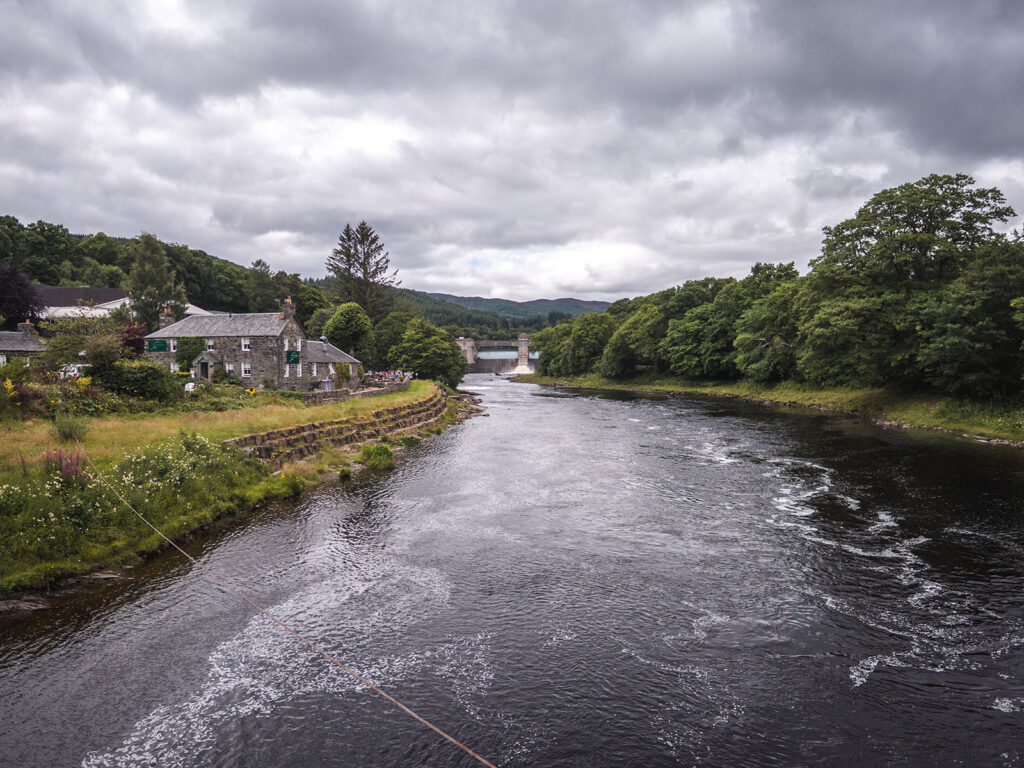
How Often does Pitlochry Dam open?
During the summer season, between April and October, Pitlochry Dam and Visitor Centre is open from 10.00am till 4.30pm on every day apart from on Mondays.
From November to March it has the same opening hours except for being closed on both Mondays and Tuesdays.
Is Pitlochry Dam Free? Pitlochry Dam Entrance Fees
Entry to the Visitor Centre as well as access to the bridge spanning the Dam are both free of charge.
Is There Parking at the Pitlochry Dam?
There is ample free parking at Pitlochry Dam Visitor Centre. During peak season this car park can get quite full so you may decide to park in one of the car parks within Pitlochry itself (for a small fee) or on-street parking.
If you decide to find some on-street parking make sure to check how long you can park there for. Some of the spots in the town centre have very short parking times so it may be wiser to park on a side-road which has unlimited parking time.
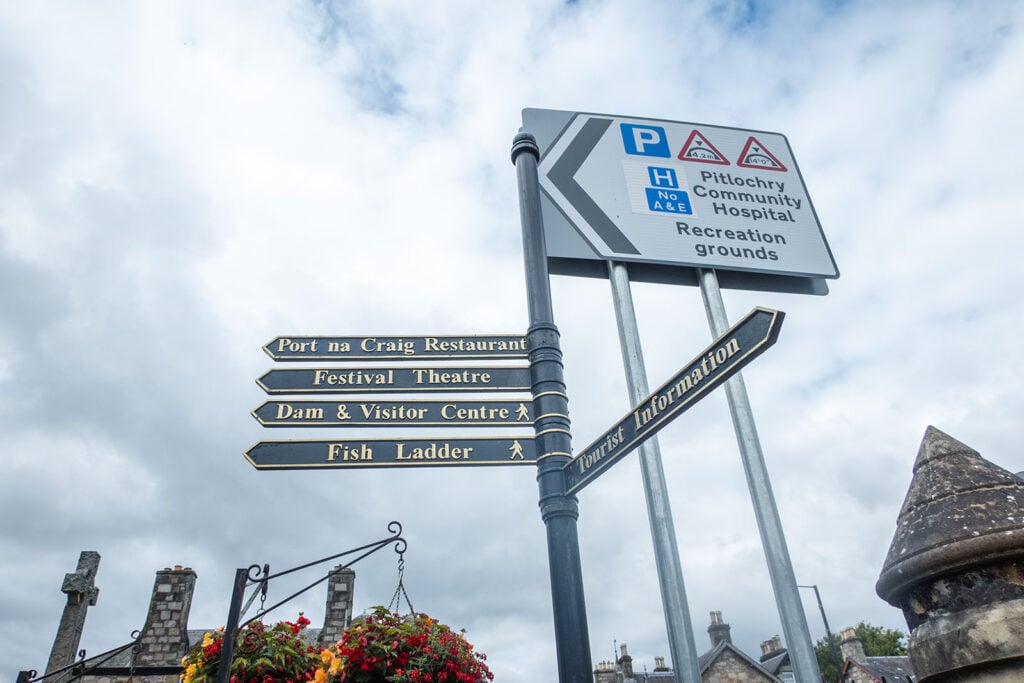
Can you get a Tour of Pitlochry Dam?
The Visitor Centre currently doesn’t offer the option to purchase an organised tour.
Personally I don’t feel a tour of the dam is necessary as the Visitor Centre provides ample information on the dam, as do various boards that you’ll encounter when walking across the dam.
The standard walk will give you more than enough information on the sights of the dam, including the extensive Visitor Centre and the opportunity to marvel at the Fish Ladder.
Can you Walk Over Pitlochry Dam?
Yes! There is a walkway which takes you across the very top of Pitlochry Dam, allowing for stunning views of both Loch Faskally above the dam and the River Tummel below.
You can also walk alongside the dam’s fish ladder which is to the left of the dam.
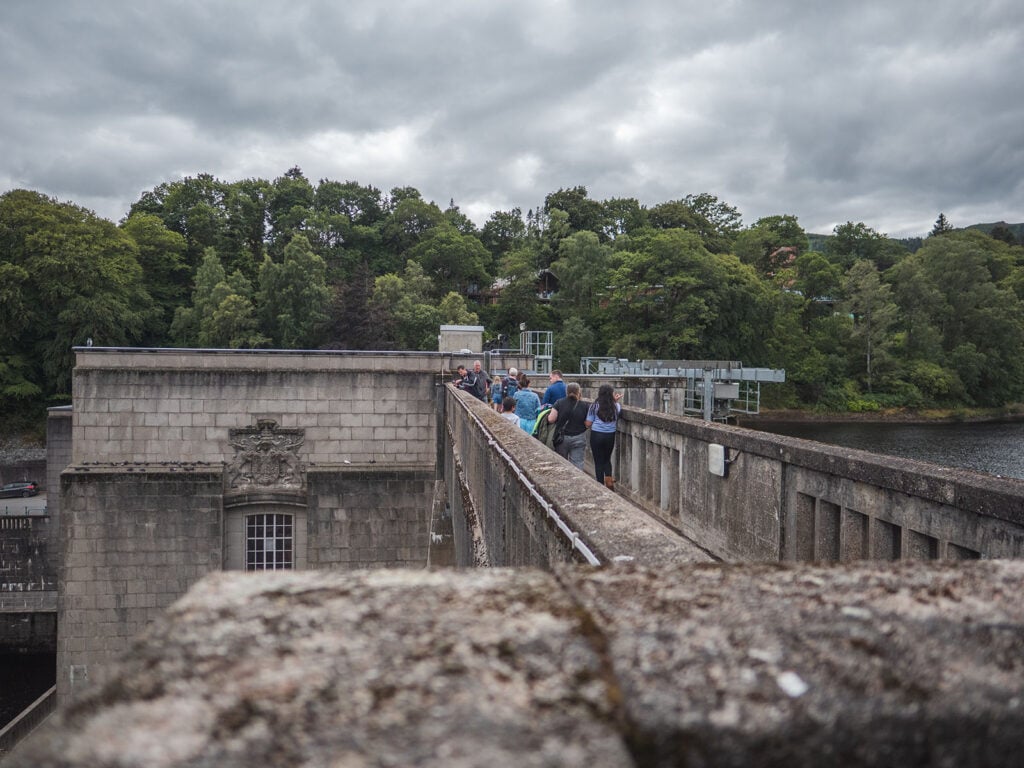
How Long is the Walk to the Pitlochry Dam?
If you park at the Visitor Centre then Pitlochry Dam is just on your doorstep. It will take you 10 minutes to walk to the other end of the dam meaning it will be a 20 minute round trip.
There are however longer walks that you can take which allow you to soak up more of Pitlochry’s ambiance and scenery. I will go into my favourite below.
Pitlochry Dam Circular Walk
This circular walk involves a stroll through charming Pitlochry town to the famous Iron Suspension Bridge, which yields stunning views of Pitlochry Dam and the River Tummel before climbing up the fish ladder to walk on Pitlochry Dam itself.

Route Overview
Walk Type: Circular
Walk Distance: 1.5 miles (2.4 km)
Walk Time: 1 hour
Walk Difficulty: Easy
Walk Description: A simple walk from the car park into Pitlochry town before walking down the main street. After 0.5km you will leave the main street, journeying down quiet roads until you reach the Iron Suspension bridge over the River Tummel. Quiet roads will then take you to Pitlochry Dam and you will end the walk at the Visitor Centre.
Terrain Description: Wide tarmac paths and pavements.
Download Maps: GPX Track
Disclaimer: These GPS files are provided free-of-charge for personal use only and may not be uploaded elsewhere. By downloading you acknowledge that walking can be dangerous and this GPS data is provided without any warranty and you absolve this website for any liability.
Stage 1: Pitlochry Town
From the Visitor Centre car park head north down Armoury Road until you reach Pitlochry town centre. Head right and follow the main street, passing numerous shops and eateries. You may wish to explore one of these quaint curio shops or stop in a café or restaurant for a bite to each.
After 0.5km on the main highway, turn right opposite Café Biba, down Ferry Road. The road will take you under the railway line before snaking through a quiet and leafy part of town.

Stage 2: The Iron Suspension Bridge
You will eventually come across a pedestrian walkway on your right which will take you to the Tummel Suspension Bridge.
The bridge was open by Kitty, Marchioness of Tullibardine – who became Duchess of Atholl – on Empire Day 1913. It was constructed to replace the Port na Craig ferry which had crossed the river since the 12th century.
The bridge cost £850 to create and is made of steel. As it is a suspension bridge, you can feel slight wobbles as you cross it, especially if there are numerous people on the bridge at once.
As you cross the bridge you will get your first glimpse of Pitlochry Dam in all its glory, gushing gallons of water into the rushing Tummel River.
On the other side of the bridge you will find yourself in the hamlet of Port-na-Craig. There is an inn and restaurant here which boasts great reviews online.
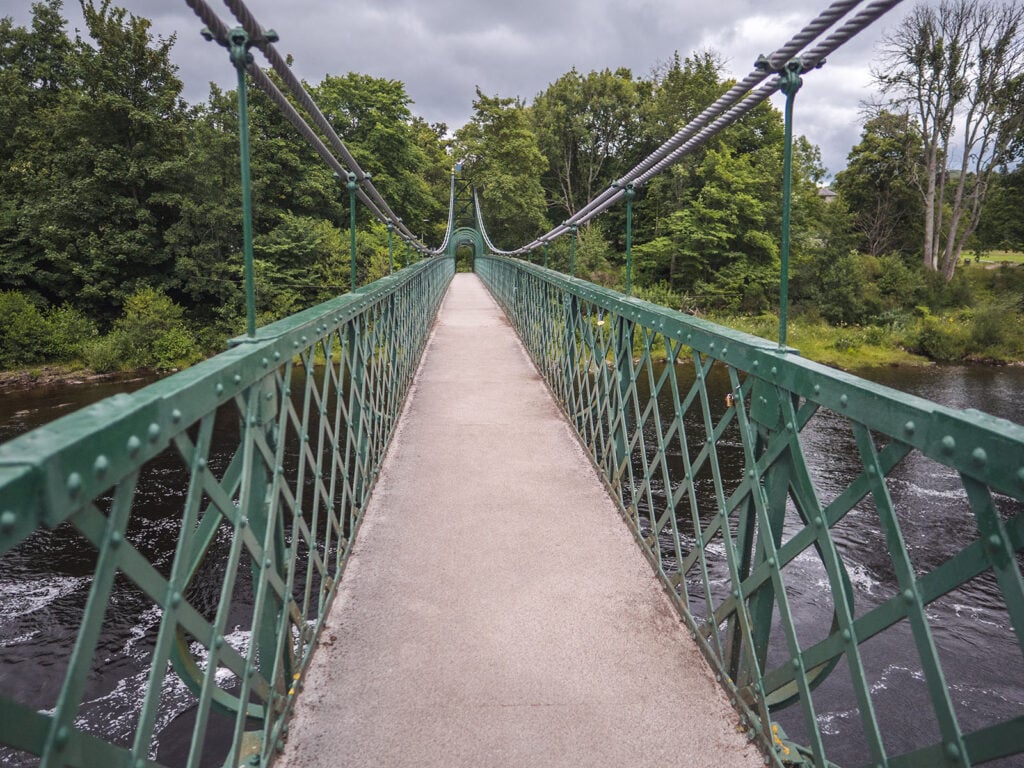
Stage 3: The Fish Ladder
Journey along Port-na-Craig road to the west and you will soon encounter Pitlochry Dam. Take the pedestrianised path which forks from the road to the left just before the dam and you will find yourself walking parallel to the famous fish ladder.
Climb up the flight of stairs, keeping a keen eye on the 34 chambers of the fish ladder to see if you can spot any majestic salmon or other fish.
This path will take you to the top of the dam, passing some windows on the way where you can see the dam in operation.
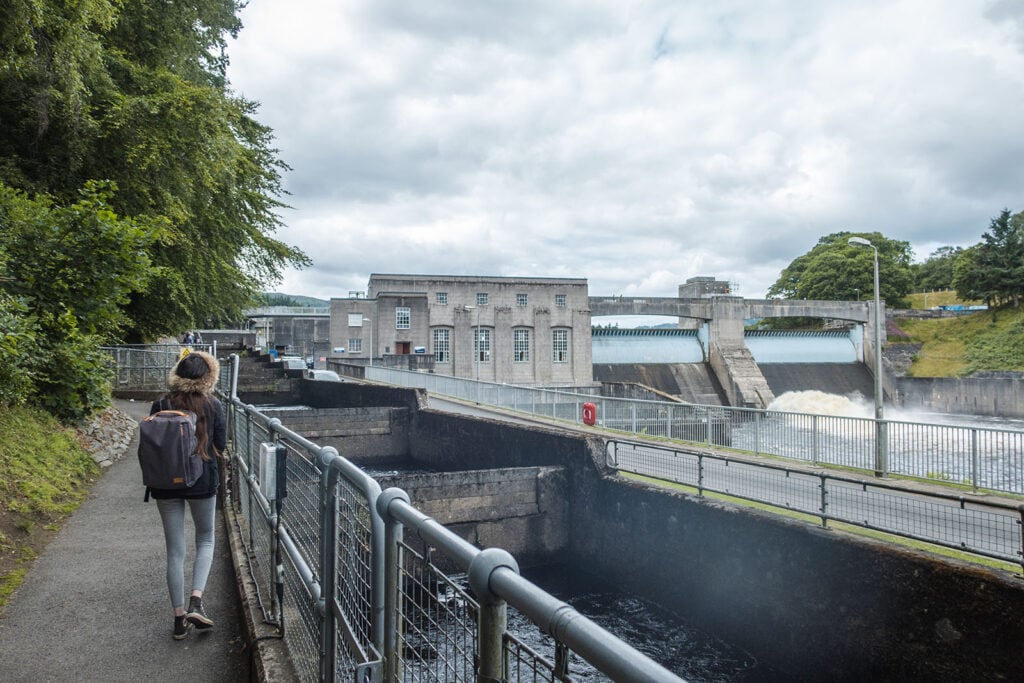
Stage 4: Pitlochry Dam and Visitor Centre
This final stretch of the walk takes you along the top of the dam where you can marvel at the dam’s power and watch the water hurtling out from beneath the dam. You will also get the chance to gaze out over Loch Faskally which is eerily peaceful in comparison to the rushing River Tummel beneath the dam, flanked by stunning forests.
At the other side of the dam you will find the visitor centre. Enter here to learn more about the dam. If you fancy a bite to eat or a hot drink you can visit the café and sit either indoors by the large windows or outdoors- if the weather permits – with a front row view overlooking Pitlochry Dam.
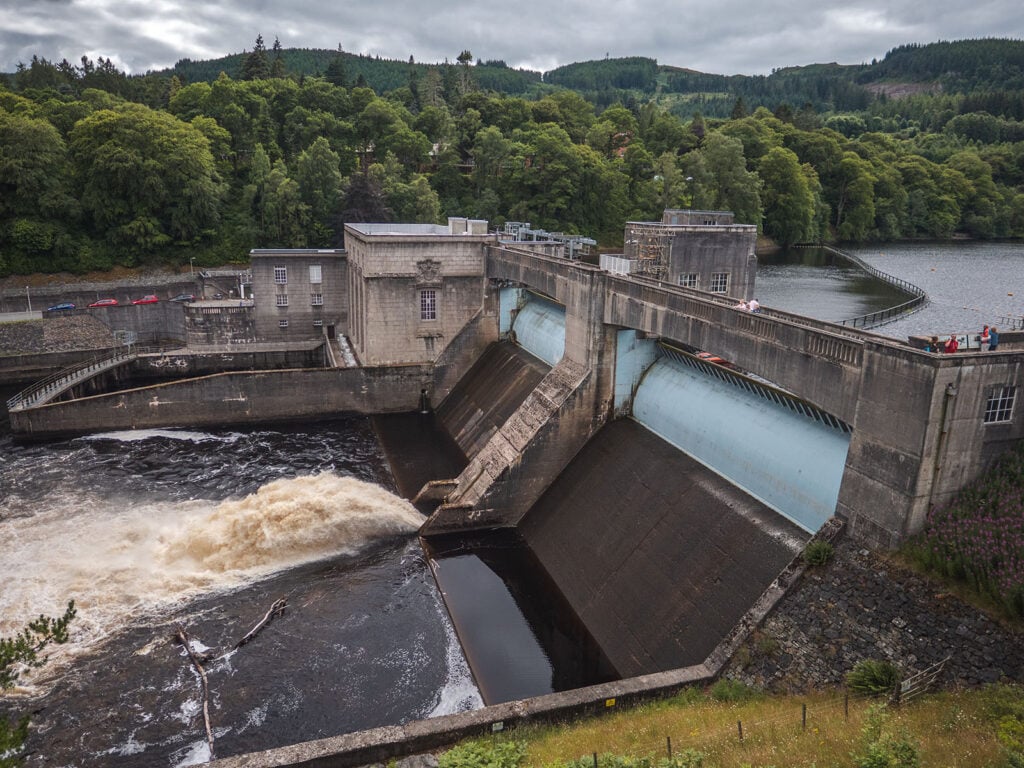
Other Things to Do in Pitlochry
As well as visiting the dam, there are a range of distinctive and memorable tourism experiences available to you when visiting Pitlochry.
Pitlochry Dam Fishing
With such an abundance of salmon and other fish in the river Tummel and at Loch Faskally, it is no surprise that angling in the waters near the dam is a very popular pastime.
Pitlochry Angling Club issues day permits for salmon fishing, or you can visit the Pitlochry Boating Station described below, which also provides permits and fishing opportunities.
The angling season runs from January to October.
Pitlochry Boating Station & Adventure Hire
One of the main tourism attractions of Loch Faskally is the Boating Station, which is just a short drive or longer walk from the dam.
The Station hires out boats for fishing as well as rowing, plus there are pedalos which can be hired for a trip onto the Loch.
The facility also hires out bikes if you want to stay on land. You can also indulge in bank fishing too, and the Station includes a nice and welcoming café along with toilet facilities.
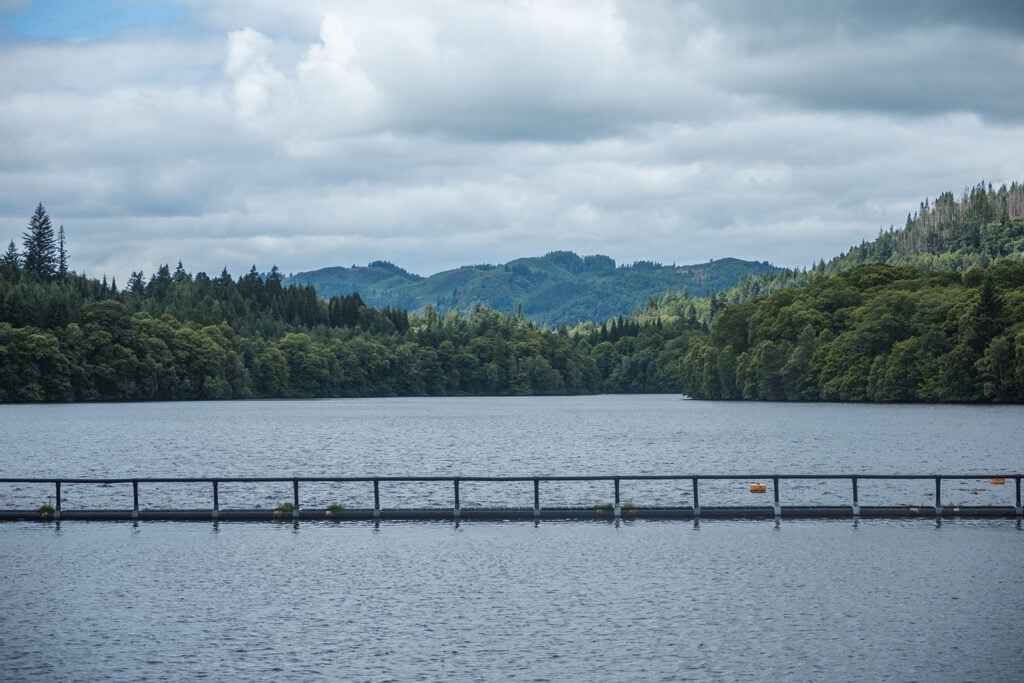
Blair Athol Distillery
The Blair Athol Distillery is a small, intimate and fascinating whisky distillery set on the Athol road from Pitlochry.
It has produced whisky for over two centuries and includes a well-regarded visitor centre from where you can purchase both fine whiskies and fascinating tours.
Walk through Faskally Forest
Faskally forest is located off the B8019, just a mile north-west of Pitlochry, and is enchanting woodland popular with locals and visitors.
It is a developed model woodland which is an excellent spot to experience the ‘Big Trees’ of Perthshire. The views and colours during the autumn are especially memorable.
The Enchanted Forest
Usually held as an annual event toward the end of September, the Enchanted Forest is a stunning sound and light show which harnesses nature as part of the event.
Held just outside Pitlochry in the beautiful Faskally Forest, the Enchanted Forest is a paid event costing around £25 per adult which has built up a regular annual audience and has won numerous tourism awards.
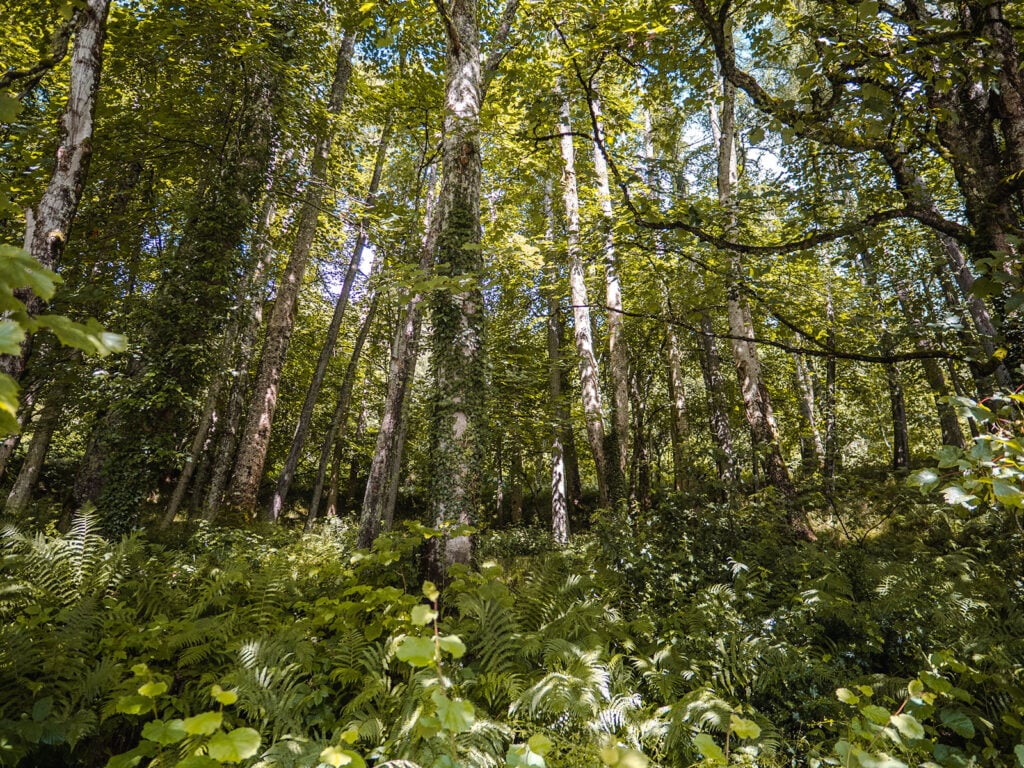
Visit Linn of Tummel
The Linn of Tummel is located just outside Pitlochry at the point where the Garry and Tummel rivers merge and is a tranquil area of woodland.
It is owned by the National Trust of Scotland and includes dozens of kilometres of established walking paths that allow visitors to get close to nature.
It includes an Edwardian fish ladder which is some fifty years older than the much larger one at the Pitlochry Dam.
Hike Craigower Hill
The hill at Craigower near Pitlochry provides an excellent viewing spot for the locality including both Loch Tummel and Loch Rannoch.
The hike to the top is a little over four hundred metres and can be quite steep in places so is not suitable unless you have a moderate degree of fitness, but those able to climb will be rewarded with an incredible vista of the area around Pitlochry.
The walk to Craigower begins at a car park around a mile north of the town.
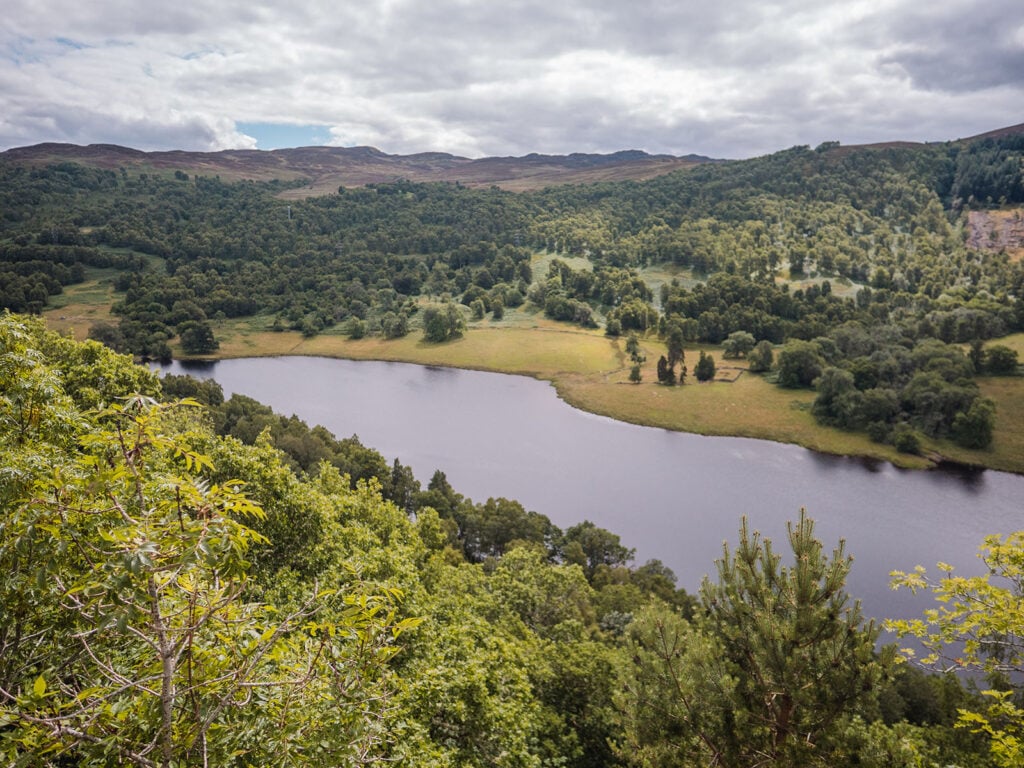
Marvel at Dunfallandy Stone
The Dunfallandy Stone, also called Clach An T-Sagart in Gaelic, is an ancient Pictish stone dating from the seventh or eighth centuries. It is made of red sandstone and around a metre and a half high.
The most distinctive aspects are the carvings on the face of the stone, with two scenes of people located with the Christian cross symbol. Also depicted are tools and snakes, making the Stone an especially unusual artefact.
It is a protected monument under Historic Environment Scotland and is free to visit at a marked site just a mile or so south of Pitlochry.
Explore Tay Forest Park
Tay Forest Park is a popular natural park to the west of Pitlochry which covers almost two hundred square kilometres.
It includes several superb and well-known viewing points like Drummond Hill and the Queen’s View, plus several small rural communities like Weem.
The Pitlochry Dam is actually located within the scope of the Park, and there are good road connections from the Dam out to many other points of note within the Park.
The area includes a number of well-established walks through the high forests that are found throughout the Park.
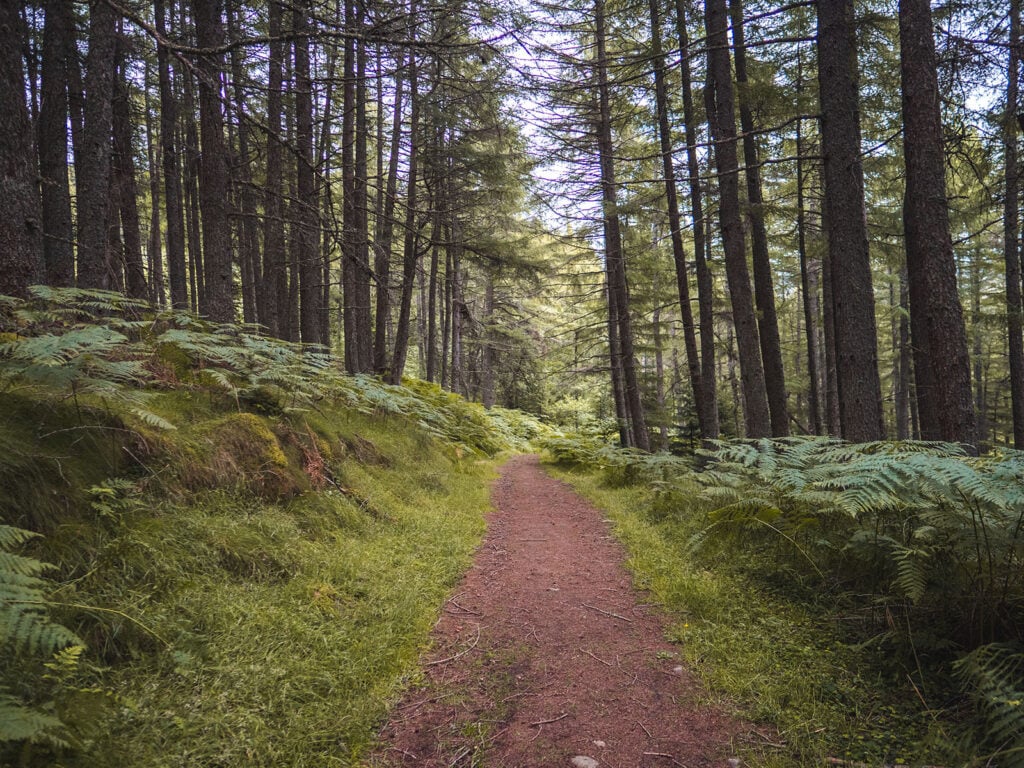
Where to Stay in Pitlochry
When it comes to accommodation there are numerous options to fit a variety of different budgets. Below are some of my favourites.
Pitlochry Hydro Hotel
Located just outside Pitlochry on the Knockard Road, the Pitlochry Hydro Hotel is a grand and spacious hotel which is one of the best in the area. Rooms vary from singles through to family rooms, with twins or doubles costing roughly £100 to £200 depending on timing and whether the room has a view or an upgrade. Rooms usually come with breakfast. The extensive on-site facilities include a spa.
Pine Trees Hotel Pitlochry
This 4-star Victorian mansion is located just outside Pitlochry. Pine Trees Hotel offers traditional Scottish cuisine and is set within 10 acres of lush woodland and gardens.
Final Thoughts: Is Pitlochry Dam Worth Visiting?
I thoroughly enjoyed my visit to Pitlochry Dam. If you are visiting then I’d highly recommend completing the circular walk above as it allows you to see more of Pitlochry town which, in my opinion, is a gorgeous town. It even has a year-round Christmas shop!
Learning about the dam is truly fascinating and it feels inspiring to be visiting a structure producing renewable energy, which is more important to civilisation than it ever has been before.
Ellamckendrick.com is a free online resource. If you have found this website useful for planning your adventures, you can show your support by buying me a coffee. Thanks so much!

Read More Perthshire Guides
Birks of Aberfeldy & the Falls of Moness: A Visitors Guide
Falls of Acharn and the Hermit’s Cave: The Ultimate Guide
Falls of Bruar: A Walker’s Guide
The Best of Loch Tay: 6 Activities You Won’t Want To Miss!
Tay Forest Park: A Complete Visitor’s Guide
Pitlochry Dam & Fish Ladder: Everything You Need to Know
Castle Menzies: A Complete Room By Room Tour

Fantastic info about the dam and Pitlochry…